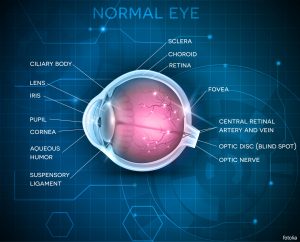PATIENT INFORMATION: Eye Implants
What … for? (Indications)
Intraocular Lenses (IOL)
IOLs are used at cataract or myopia
– Anterior chamber lenses
Phakic (remaining natural lens). Refractive lenses are used for myopia, presbyopia and high hyperopia, if laser or corrective lens treatment is not done.
– Posterior chamber lenses
Aphakic (no lens). Used at cataract, the replacement of the natural lens.
Glaucoma Filtration Device
Glaucoma filtration devices are used to control intraocular pressure (IOP), at previously failed trabeculectomy, at insufficient conjunctiva, scarring and complicated glaucomas.
Artificial Iris/Retina
Partial or complete aniridia
Capsular tension ring
Cataract, a.o.
Special implants
– Diplopia Implant
– Pupil Dilator
– Implants for Children
Epiretinal Prosthesis
Blindness
Eye Prostheses
Trauma, Cancer
Numbers
Global 19Mio 2010, 19.7Mio 2012 IOL
Cataracts account for 48% of world blindness.
Germany: 650.000 Cataract surgeries/year
Times
Recovery from the procedure is usually within 24 hours.
Contraindications
(some may be relative)
behavioral
Specific job requirements (e.g. pilot, public service vehicle). Night vision important. Low change of myopia.
medical
Retinitis pigmentosa. Stargardt disease. Macular diseases. Any abnormality of the optic nerv. Fuchs corneal dystrophy. Macular degeneration. Diabetes mellitus.
Risks
during surgery
Mechanical trauma
short term
No improvement, infection (0.03-0.05%), rotation of the lens, lose of vision.
long term
Secondary cataract (0.6%), yearly loss of 1.8% of the endothelial cells, retinal detachment, corneal swelling (0.4%). Glaucoma, Glare, Halo (FDA)
restrictions
Loss of accommodation, minimized with multifocal lenses (slight double vision, reduced contrast), difficulty with performing tasks like driving at night or in fog.
Failures
Mechanical trauma, infection, optical problems
Material
Intraocular Lenses
Hydrophilic (25%) acrylic, hydrophobic acrylic, hydrophilic with hydrophobic surface, PMMA
Light adjustable lens
Silicone + Macromers sensitive to ultraviolet light
Artificial Iris
– Polymer fiber meshwork (for suturing)
– Fiber free
Capsular Tension Ring
PMMA
Aniridia Rings
Black pemA
Cornea Implants, Cornearing
Ceralloy-Titanium
Glaucoma Filtration Device, valved/nonvalved
Stainless steel, Acrylics
Epiretinal Prosthesis
Antenna, electronic case, electrode array
Eye Prostheses
Glass
Statistics
No longterm studies with appropriate numbers available.
Literature
– Basic
Phakic Intraocular Lenses
Capsular tension ring:
Tribus C et al: Indications and clinical outcome of capsular tension ring (CTR) implantation: A reviw of 9528 cataract surgeries, Clin Ophtalmol v.1(1), 2007 Mar
– Problems
13.88% developed clinically relevant cataracts (with IOL, older model)
Half of explantation were caused by cataract. Alio et al. Phakic intraocular lens explantation: causes in 240 cases. J Refract Surg. 2015 Jan; 31(1): 30-5.
– Science/Future
Light adjustable lenses
Medical societies
Criticism
PMMA vs foldable lenses, Hard vs Soft
FDA: What are he risks?
Selected Patient Information
Register for Patients
n/a, no specific registry known
In the register of the registries you can check which ones are available.
If your implant is not covered:
The Implant-Register offers registration of implants online and you can download a printable version for your personal use.
Disclaimer
The information and links and whatsoever shown on this page are compiled with care. However, Implant-Register can´t take any responsibility for the information given, nor their content, nor their up-to-date nature, particularly in interlinked pages. You may help us with your contribution, granting us the decision to publish or not. Be careful with conclusions for yourself, in doubt double-check and consider medical solutions are individual and have to be found with an educated medical person.

